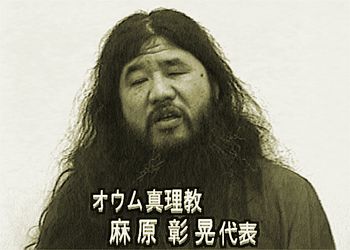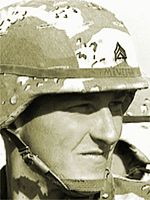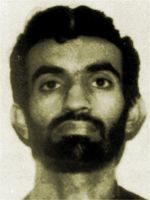The 'New Terrorist':
Willing to Kill for the Sake
of Killing
Random and Unpredictable
By David Phinney
ABCNEWS.com
Talking
to God?: Members of the 10,000-strong Aum Shinrikyo cult, led by Shoko Asahara
(above), killed 12 and left thousands ill after a nerve gas attack on the Tokyo
subway system. Members also had plans to attack New York and Washington, D.C.
(AP Photo)

An Ohio microbiologist with ties to white supremacists anxiously awaits a
shipment of mail-order vials containing bubonic plague—until federal
authorities find and arrest him.
-
In Oregon, investigators now believe an outbreak of salmonella food
poisoning in Portland salad bars that made more than 700 ill and
hospitalized dozens was the work of a religious cult hoping to sabotage
voter turnout on Election Day.
-
In Long Island, New York, authorities say a small group plotted to put
radioactive material in the toothpaste and food of a small town’s local
government officials.
-
Police in Washington, D.C., cordoned off a city block and quarantined
workers when a petri dish oozing with a red substance labeled anthrax
arrived in the mail at the headquarters of B’nai B’rith, a national
Jewish organization. The event was later found to be a hoax.
A
Troubling New Wave
Not surprisingly, these sorts of bizarre occurrences—and their random,
anonymous nature—severely frighten law enforcement officers and defense
analysts. As they count the mounting
numbers of similar incidents, they see a troubling new wave of
terrorism emerging—its soldiers able to choose from a gruesome arsenal of
biochemical weapons that could potentially kill thousands of unsuspecting
citizens. In addition, the more familiar brand
of terrorist still exists.
|

The 1995 bombing of the Oklahoma City federal building demonstrated
a greater willingness by terrorists to commit mass murder on U.S.
soil, terrorism analysts say. Timothy McVeigh (photographed during the
Gulf War), was convicted of the crime that killed 168 people. (AP
Photo)
|
At the same time, access to biological and chemical agents has gotten easier.
Technical information on making and acquiring them is easily available over
the Internet. Ingredients can be purchased through the mail. And the process
of making them can be seen on homemade videos and discussed at gun shows and
survivalist meets.
“We’re not in Kansas anymore, Toto. There are
people out there thinking about using these weapons,” observes Amy Smithson,
an expert on terrorism and weapons of mass destruction at the Henry L. Stimson
Center in Washington. “It is very possible someone might go to a sporting
event or convention and decide to put some sarin or anthrax next to the
ventilation shaft.”
Defense analysts now fret over scenarios of small
groups sneaking over the nation’s borders with biochemical weapons provided
by rogue nations. For decades such terrorists have usually been
state-sponsored groups who attack to manipulate public opinion and emotions.
Or they may be in the mold of the Irish Republican Army or the Palestine
Liberation Organization, seeking political legitimacy.
Longing
for Greater Violence
But a new kind of terrorist also has stepped on the stage. They lack the
ideological anchor to a defined political movement. They frequently long for
violence as a way to cleanse society or express racial hatred. They are
willing to spawn large-scale destruction and kill more people than ever
before—and they feel little need to claim credit for an attack.
“The increase in anonymity may be because
terrorists are carrying their act out in the name of God and they don’t need
an audience in the Washington Post or on ABCNEWS,” offers Dr. Jerrold
Post, a prominent profiler of terrorists and author of Political Paranoia:
The Psychopolitics of Hatred.
Analysts claim this new kind of terrorism already has
arrived, demonstrating a greater willingness to commit wholesale murder and
exposing the vulnerability of Americans to sudden, far-reaching attacks.
“Instead of having a lot of people watch, they want a lot of people dead,”
notes Brad Roberts with the Institute for Defense Analysis, in Washington,
D.C.
Mass
Destruction on the Rise
The 1993 bombing of the 110-story World Trade Center left six dead and 1,000
wounded. But had the terrorist ringleader Ramzi Yousef succeeded in his goal
to topple one of the world’s tallest buildings, perhaps 250,000 could have
been murdered.
|

Ramzi Yousef was convicted of masterminding the 1993 World Trade
Center bombing that left six dead and 1,000 wounded. Authorities now
estimate the cost of the destruction near $1 billion, but Yousef said
he failed. He sought to destroy one of the world’s tallest buildings
and kill up to 250,000 people. (AP Photo)
|
Two years later, a two-ton fertilizer bomb blew open the Alfred P. Murrah
federal building in Oklahoma City. As Timothy McVeigh fled the scene of his
crime, he left 168 people dead, 500 wounded, and an entire nation in shock.
Though both have been found guilty, neither McVeigh
nor Ramzi ever claimed credit. The act became an end unto itself.
“Terrorists used to identify themselves—now they
don’t,” notes Dr. Richard Ward, who heads the Office of International
Criminal Justice with the University of Illinois. “We probably won’t have
mass movements or guerrilla activities as in the past. And because of the
sophistication of intelligence, the more effective way for terrorists to work
is in cells and small groups.”
But others worry about religious groups possessed
with notions of bringing on the apocalypse—especially at the turn of this
century.
Talking
to God
“These new terrorists have no clear political constituency—they think they
talk to God and it’s a god that seems to encourage violence. That’s
what’s new,” says Jessica Stern, a former chemical and biological weapons
specialist with the National Security Council. Her job inspired the Hollywood
movie, Peacemaker.
“These kinds of groups might turn to extreme
violence and weapons of mass destruction because they believe Armageddon is
coming in the year 2000,” she says. “They want to hasten the appearance of
the Messiah.”
End of
the World As We Know It
Many view the cult Aum Shinrikyo as a group seeking to bring on the end of the
world.
The religious organization, officially recognized in
Japan, harbored plans to attack the United States with biochemical agents. The
cult leaders planned to produce enough to annihilate a large Japanese city by
spraying it from a Russian helicopter they purchased.
Cult members let loose a bag of low-grade sarin nerve
gas after poking it with umbrellas on a Tokyo subway in 1995. The attack killed
a dozen people and left thousands ill. Investigators subsequently discovered
leaders of the international, 10,000-member cult had been stockpiling anthrax
and botulin toxin, two of the world’s most deadliest germ-warfare agents.
Aum Shinrikyo had offices in New York and an estimated
$1.5 billion in assets. It has now been linked to two biological and five
chemical attacks, including a 1994 incident that killed seven and injured 500.
But the group’s activities took the FBI and CIA by
surprise. At Senate hearings, CIA and FBI officials admitted they were unaware
Aum Shinrikyo had been developing chemical and biological weapons. They first
heard about the cult’s goal for igniting a cataclysmic war between Japan and
the United States from reports in the news media. 
Send mail to webmaster@theppsc.org with questions or comments about this web site.
©2004 The Police Policy Studies Council. All rights reserved. A Steve Casey design.
|




